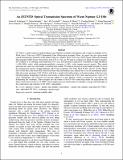An HST/STIS Optical Transmission Spectrum of Warm Neptune GJ 436b
Author(s)
Lothringer, Joshua D.; Benneke, Björn; Crossfield, Ian J. M.; Henry, Gregory W.; Morley, Caroline; Dragomir, Diana; Barman, Travis; Knutson, Heather; Kempton, Eliza; Fortney, Jonathan; McCullough, Peter; Howard, Andrew W.; Dragomir, Diana; ... Show more Show less
DownloadLothringer_2018_AJ_155_66.pdf (1.377Mb)
Terms of use
Metadata
Show full item recordAbstract
GJ 436b is a prime target for understanding warm Neptune exoplanet atmospheres and a target for multiple James Webb Space Telescope (JWST) Guaranteed Time Observation programs. Here, we report the first space-based optical transmission spectrum of the planet using two Hubble Space Telescope (HST) Space Telescope Imaging Spectrograph (STIS) transit observations from 0.53 to 1.03 μm. We find no evidence for alkali absorption features, nor evidence of a scattering slope longward of 0.53 μm. The spectrum is indicative of moderate to high metallicity (∼100-1000× solar), while moderate-metallicity scenarios (∼100 solar) require aerosol opacity. The optical spectrum also rules out some highly scattering haze models. We find an increase in transit depth around 0.8 μm in the transmission spectra of three different sub-Jovian exoplanets (GJ 436b, HAT-P-26b, and GJ 1214b). While most of the data come from STIS, data from three other instruments may indicate this is not an instrumental effect. Only the transit spectrum of GJ 1214b is well fit by a model with stellar plages on the photosphere of the host star. Our photometric monitoring of the host star reveals a stellar rotation rate of 44.1 days and an activity cycle of 7.4 years. Intriguingly, GJ 436 does not become redder as it gets dimmer, which is expected if star spots were dominating the variability. These insights into the nature of the GJ 436 system help refine our expectations for future observations in the era of JWST, whose higher precision and broader wavelength coverage will shed light on the composition and structure of GJ 436b's atmosphere.
Date issued
2018-01-16Department
MIT Kavli Institute for Astrophysics and Space ResearchJournal
The Astronomical Journal
Publisher
American Astronomical Society
Citation
Lothringer, Joshua D., Björn Benneke, Ian J. M. Crossfield, Gregory W. Henry, Caroline Morley, Diana Dragomir, Travis Barman, et al. “An HST/STIS Optical Transmission Spectrum of Warm Neptune GJ 436b.” The Astronomical Journal 155, no. 2 (January 17, 2018): 66. © 2018 The American Astronomical Society
Version: Final published version
ISSN
1538-3881